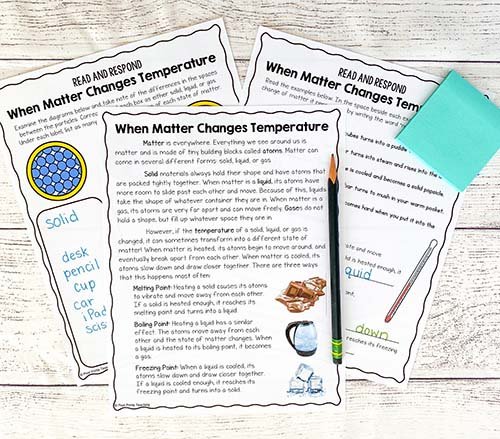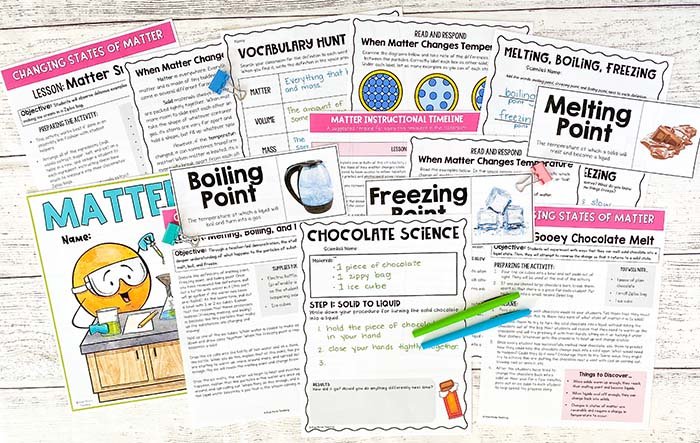Changing States of Matter for Kids - Science Lessons in Elementary
Matter is all around us, as you might remember from your elementary school days, the states of matter can change. And when it comes to teaching kids about the changing states of matter, there are so many different activities we can do. Let’s take a look at some activities we can do to teach about the changing states of matter.
How does matter change states?
Matter is made up of atoms. And for the purpose of elementary school, there are three states of matter: solids, liquids and gases. Temperature has the ability to change the state of matter. When heat is added, the atoms move around and eventually break apart from each other. When matter is cooled, the atoms slow down and draw closer to each other.
The most common ways that temperature affects matter is through melting, boiling and freezing.
What is matter? Take a peek at this post that’s just about teaching the 3 states of matter!
We always start our unit with a set of reading passages on matter. I find that it helps to give students some background information before we dive into hands-on learning.
Changing States of Matter Videos
As always, I like to have some YouTube videos on hand in case we have a few extra minutes throughout the day. These are a couple videos I found that teach about the changing states of matter:
https://www.youtube.com/watch?v=zwCUqG7GA3Y
This video gives an overview of the states of matter and atoms. It also delves into the changing states of matter through melting and freezing.
https://www.youtube.com/watch?v=gZBt4_Ds3lI
Here’s a brief video that explains about boiling point. It also explains why popcorn pops because of the boiling.
Make it Delicious with Chocolate
‘Gooey Chocolate Melt’ is the most delicious experiment to teach changing states of matter. Find it here!
This is a fun activity that explores melting and cooling using chocolate. So not only is this experiment educational, but it’s also tasty!
In a nutshell, this experiment has students using their problem-solving skills to turn solid chocolate into a liquid. Each students will get their own bag with some chocolate in it. They have to figure out how to melt the chocolate. Then students will have to make predictions about how they can change the melted chocolate back into a solid.
And of course, when the experiment is finished, each child can eat their chocolate!
matter + hot chocolate?
Another great way to explore the changing states of matter is to make hot chocolate. You can even have students write about whether they think whipped cream is a liquid or a solid….what do you think it is?
Show Melting, Boiling and Freezing
For this experiment, you’ll need an electric kettle with water. A transparent kettle is best because then students can see what’s happening inside. You’ll also need ice cubes. After reviewing the definitions of melting, boiling and freezing, pull out a kettle filled with water and also put ice cubes in a bowl.
Drop an ice cube into the water and watch what happens. Then turn on the kettle and watch what happens. As the ice cube melts and the water heats up, steam will form.
Throughout the whole process, explain to students what is happening and have students record their observations.
Plan Your Changing States of Matter Lessons with a CLICK
Looking for a FAST way to prep that Changing States of Matter unit that includes nonfiction text AND engaging experiments? In just a few clicks you can grab all of the pieces you need: scripted instructions, vocabulary, informational text, experiments, and more.
Click and print. Planning is really that easy.
matter game
If you want to do an extension of the above activity, have your students pretend to be molecules and act out the process of melting, boiling and freezing.
Have students stand close together to be the ice. Then have them move further apart to be liquid and far, far, far apart to be gas. When you say “freezing” students will stand close together. When you say “melting” students move further apart. When you say “boiling” students have to move furthest apart.
Into Thin Air
If you have a few days to do an experiment, you can give each child or group of children a cup. Have them fill it with water and draw a line to mark the water level. Then have the students place their cups in a sunny place, like the window sill of the classroom. Over the next few days have students make observations about the water level.
Hands-on activities work so well for learning about the changing states of matter! When our students can use their five senses (yes, I’m including taste!), science comes alive on a whole new level!





